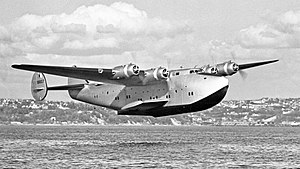Boeing 314 Clipper
| Boeing 314 Clipper | |
|---|---|
 |
|
| A Boeing 314 flying low | |
| Role | Flying boat airliner |
| Manufacturer | Boeing Airplane Company |
| First flight | June 7, 1938 |
| Introduction | 1939 |
| Retired | 1946 |
| Status | Retired |
| Primary users |
Pan American World Airways British Overseas Airways Corporation United States Navy |
| Produced | 1938–1941 |
| Number built | 12 |
The Boeing 314 Clipper was a long-range flying boat produced by the Boeing Airplane Company between 1938 and 1941. One of the largest aircraft of the time, it used the massive wing of Boeing’s earlier XB-15 bomber prototype to achieve the range necessary for flights across the Atlantic and Pacific Oceans. Twelve Clippers were built; nine were brought into service for Pan Am and later transferred to the U.S. military. The remaining three were sold to British Overseas Airways Corporation (BOAC) by Pan Am and delivered in early 1941. (BOAC's 3 Short S.26 transoceanic flying-boats had been requisitioned by the RAF).
Pan American had requested a flying boat with unprecedented range that could augment the airline's trans-Pacific Martin M-130. Boeing's bid was successful and on July 21, 1936, Pan American signed a contract for six. Boeing engineers adapted the cancelled XB-15's 149 ft (45 m) wing, and replaced the 850 hp (630 kW) Pratt & Whitney Twin Wasp radial engines with the 1,600 hp (1,200 kW) Wright Twin Cyclone. Pan Am ordered six more aircraft with increased engine power and capacity for 77 daytime passengers as the Boeing 314A.
The huge flying boat was assembled at Boeing's Plant 1 on the Duwamish River in Seattle, and towed to Elliott Bay for taxi and flight tests. The first flight was on June 7, 1938, piloted by Edmund T. "Eddie" Allen. At first the aircraft had a single vertical tail, and Allen found he had inadequate directional control. The aircraft returned to the factory and was fitted with the endplates on the ends of the horizontal tail in place of the single vertical fin. This too was found to be lacking and finally the centerline vertical fin was restored, after which the aircraft flew satisfactorily.
...
Wikipedia
